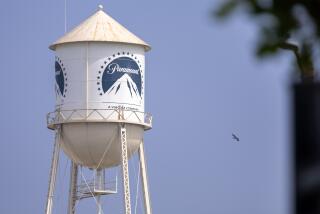Back in Tune : Norman Pattiz and the Comeback of Westwood One
Norman J. Pattiz achieved one of the great entrepreneurial successes in the Southern California entertainment business and then watched it nearly go down the tubes.
The rise and fall and survival of Pattiz has taken place without the attention it might have gotten in the television or movie business. But Pattiz made his fortune in that other entertainment medium, radio.
As Pattiz is fond of pointing out, Los Angeles is the nation’s largest radio market. “In many ways, this is a company town for the movie and TV business. Radio is the Rodney Dangerfield of the entertainment business. . . . When you tell people that radio is a $12.5-billion industry . . . and you point out that’s more than domestic box-office receipts and it’s more than domestic record sales, it kind of puts it in perspective. . . . People spend as much time listening to the radio as watching television.”
Today, the company Pattiz founded, Westwood One, whose core business is national radio programming, has returned to health and its stock price is rising. But it has done so primarily because Pattiz gave up management of the company and, as far as Wall Street is concerned, got out of the way.
Pattiz, 53, remains chairman of the board, but in a much diminished role. Slice by slice, he’s selling off his stake in the company, down now to about 3%.
In another age, there might have been something tragic about Pattiz’s fall from grace as one of the highly regarded entrepreneurs of the 1980s.
But this is the entertainment business. Feel no sadness for Pattiz. He has a comfortable contract that provides him with perks and, with bonuses, more than $1 million a year.
From his loft offices at the Westwood One headquarters in Culver City, Pattiz still makes the broadcast deals with rock bands. He has struck up an acquaintanceship with the president of the United States. And he continues to cut a wide swath of exuberant living, much as he did when he was a lightning rod for Wall Street critics who said his overspending was killing the company.
He tools around town in his Aston Martin, weekends on his 60-foot Tempest, “a big go-fast boat” that can take him and his wife, Mary, to Catalina in an hour, and goes to every Lakers game he can. Pattiz and his wife spent more than $100,000 last month in the Jackie Onassis auction, purchasing a 19th-century desk and a publisher’s manuscript of “Profiles in Courage.”
Pattiz’s office is decorated with pictures of him with his friends: Magic Johnson on the night Johnson returned to basketball in his latest comeback, “Don and Melanie” (Johnson and Griffith), Yoko Ono (“an old friend”), Ted Turner and Jane Fonda, Ted Kennedy (“the first politico I got to know well”) and Bill Clinton, a politico Pattiz has gotten to know more recently.
In short, Pattiz, the middle-class kid who grew up in Mar Vista, is just delighted with where life has taken him.
“It’s a miracle,” Pattiz said. “I never expected this . . . and if I can do it, lots and lots of other people can.”
He has made something more than $100 million from Westwood One and says he is devoting himself to philanthropic causes, including an effort to create a national academic center for radio, perhaps at UCLA. (Pattiz is scouring the L.A. radio band in search of a broadcast license for UCLA.)
*
In 1975, Pattiz had the notion that you could package programming for radio stations and make a good business of it by selling some of the commercial slots nationally. The company distributed programs such as Casey Kasem’s countdown shows and “The Dr. Demento Show.” (Today, the company continues to distribute Kasem’s programs, as well as those of personalities Don Imus, G. Gordon Liddy and Larry King.)
Thanks in large to Pattiz’s considerable skills as a salesman and programmer, he grew the company at a remarkable rate. After it went public in 1984 at close to $5 a share, it became a darling of Wall Street, rising into the $30-a-share range in 1987. Part of Pattiz’s strategy was to acquire competitors in the programming business, and along the way he took control of the Mutual Broadcasting System and NBC Radio Networks. Westwood One became the country’s largest supplier of radio programming.
Like many entrepreneurs, Pattiz had more success when he was growing the company pell-mell than he did running it when it got big. The company lost its way when Pattiz began acquiring radio stations and other businesses that were outside the core programming business.
In 1988 the company hit a wall, announcing its first-ever quarterly loss. A recession hit national radio advertising at the same time the company had deeply leveraged itself to make acquisitions.
Pattiz became a target of Wall Street critics who challenged the company’s strategy and questioned its accounting practices. The stock dropped to less than $2 a share, and for several years the view spread that the company might not survive.
Pattiz, who had sold about $65 million in stock during public offerings in the 1980s, bought the stock back when it was low. “I believed in my gut that this was a solid business with solid assets in a solid position in our industry, and that I would find a way to get the value back in the stock,” he said.
The company dumped the radio stations it bought, cut debt, reduced the payroll and focused on its core business.
In 1994, Pattiz made the most important move, a deal with Infinity Broadcasting, one of the largest owners of radio stations, which bought about a quarter of the company and took over its management.
The chief executive of Westwood One today is Mel Karmazin, the Infinity CEO who is regarded as one of the shrewdest managers in the radio business. Westwood stock closed Monday on Nasdaq at $18, unchanged.
The company reported earnings of $9.7 million for 1995, after three years of losses.
One analyst of the company said recently, “The company is back on track for reasons having nothing to do with Norm Pattiz. It’s all because of Mel Karmazin. . . . When Pattiz originally built the business, he did some right things, but then he over-leveraged and he went Hollywood, spent his time at Laker games.”
Pattiz winces at such sentiments, but recognizes that as far as Wall Street was concerned, he was damaged goods. (Shortly before the management agreement was signed with Infinity, Westwood One settled an SEC complaint by agreeing to change its accounting practices.)
“There were the days when I’d go out on a roadshow and the stock would move up because of it. Mel still has that effect. For me to think that I was still held in the same esteem by Wall Street as I was in 1987 was folly . . . . The most important thing that happened to turn the company around was to make a deal with Infinity Broadcasting . . . and giving the CEO title to Mel Karmazin.”
Pattiz still holds a huge chunk of the voting shares of Westwood One, but as part of the deal with Infinity, those shares must be voted with the board.
*
Karmazin, in a phone interview from his New York office, said that although he is in charge of the nuts and bolts of the company, Pattiz still plays a role in “the arts and crafts part of things.”
“Norm never had a lot of interest historically in dealing with bankers and lawyers,” Karmazin said, “. . . and I’d rather go through root canal than be backstage at a rock concert.”
Pattiz primarily occupies himself at work today with programming for the network. He set up a “radio town meeting” with Clinton being interviewed by Larry King last September. (Earlier, Clinton had asked Pattiz for advice about how to deal with conservative talk radio.)
“The things that I’ve always liked to do are the things that I continue to do,” said Pattiz. “I’ve always been very active in securing artists for specials.” He mentions the Rolling Stones, REM, Barbra Streisand and the Eagles.
He still keeps in touch with major advertisers by “having dinner, taking them to a Laker game.”
Pattiz wants to make a contribution to the education of future radio managers. He has donated funds to Hamilton High School in Los Angeles, which he attended. He also is a trustee of the new Museum of Television and Radio in Beverly Hills, and he’s currently the president of the Broadcast Education Assn., a national professional development organization.
Pattiz becomes particularly animated talking about his idea for a major academic center for radio, which he has discussed with UCLA officials.
“Of course, I would be expected to help them get [a broadcast] license and commit and raise the funds to operate it, but I believe that’s doable.”
*
About the future of radio and network programming, Pattiz is, naturally, bullish, but he sees huge changes because of consolidation in the industry.
“In the next couple of years, you will find that in major markets almost every station will be owned by a handful of operators, and in medium and small markets one operator will own most of the cash flow.”
His contract with Westwood One ends in 1999, but he would like the current arrangement to last. “If Karmazin was to say and I felt the shareholders felt I should ride off into the sunset, I certainly wouldn’t cause trouble. But I don’t expect that to happen.”
(BEGIN TEXT OF INFOBOX / INFOGRAPHIC)
Radio Days
Quarterly stock prices for Westwood One Inc. from August 1984 to March 1996:
1984: Westwood Onw goes public.
1987: Stock price hits a high.
1984-1987: The company becomes a darling of Wall Street, emerging as the country’s largest supplier of radio programming.
1988: The firm reports its first quarterly loss. Stock price plummets.
1994: Infinity Broadcasting takes over management of Westwood. Stock price triples.
1996: Analysts regard the company as back on track.
Source: TradeLine. Researched by JENNIFER OLDHAM / Los Angeles Times
More to Read
The biggest entertainment stories
Get our big stories about Hollywood, film, television, music, arts, culture and more right in your inbox as soon as they publish.
You may occasionally receive promotional content from the Los Angeles Times.










